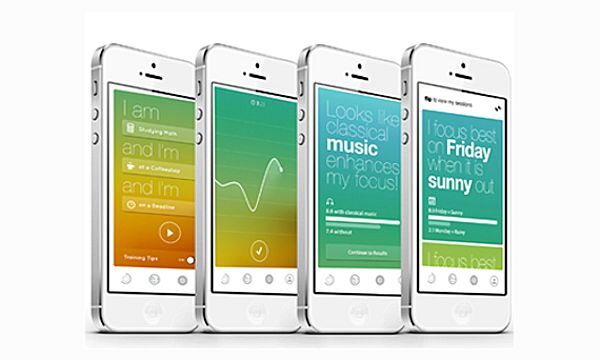Thinking about how accurately and effectively you are thinking is an exercise from which many of us could profit. Unfortunately, this is a serious challenge for most people. Rather like thinking about your golf swing, or just how to hit that high C, self-examination tends to modify or destroy the mental processes that were to be evaluated. Fortunately, we are in the age of personal EEG monitors, of which the latest entry is the Melon (which briefly surfaced previously as the Axio), a Kickstarter project to manufacture a headband EEG monitor designed to measure mental focus.
Electroencephalography (EEG), a collection of methods for monitoring the electrical activity of the brain, has been a research and diagnostic tool for the brain since the first human scalp EEG was recorded in 1924. The electrical activity of the brain is the result of ionic currents driven by billions of neurons reacting to their inputs and their external electrochemical environment.

An electrode placed on the scalp only detects a whisper of the true electrical activity of the brain because of signal loss from passing through the brain membranes, the skull, and the scalp. The signal that remains is a few tens of microvolts in size, making noise-free detection a tricky problem. In addition, passing through the skull has the effect of spreading out the electrical signals, so that an EEG is always the integrated response of huge numbers of neurons.
Brain imaging studies carried out with magnetic resonance imaging (MRI) and positron emission tomography (PET) scanners have provided a great deal of evidence concerning which parts of the brain appear to become active during various activities. However, at least part of the function of the prefrontal cortex has been known since 1848.

In that year, a man named Phineas Gage, the foreman in charge of blasting rock for a railroad company, was placing a powder charge into a drill hole by tamping it with a tamping iron more than an inch in diameter. The powder exploded prematurely, driving the tamping iron through Gage's skull before landing some 80 feet away.
Once Gage had substantially recovered, he was no longer the same person. His physician, Dr. John Martyn Harlow, remarked that, "the equilibrium or balance, so to speak, between his intellectual faculties and animal propensities, seems to have been destroyed." In essence, Gage's ability to temper or moderate his behavior in view of future consequences had been destroyed. This is an important part of what is now called the executive function of the brain.
The executive function of the brain includes attention, abstract thought, planning, problem solving, inhibitions (control of activities that work against one's inner intentions), and mental flexibility. These would all seem to be associated with mental focus, although a precise definition of that term does not exist. Accordingly, an evidence-based belief has formed that activity in the left prefrontal cortex is evidence of effective mental focus, with more activity indicating better focus.

The Melon is a personal EEG device whose intent is to monitor and provide feedback about the level of general brain activity in the left prefrontal cortex. It is a rather streamlined headband that transfers its readings by Bluetooth to a computer or smartphone. The intent of the design team is that the Melon should allow users to discover how time of day, amount of sleep, weather conditions, hunger, environment, boredom, and other factors influence their ability to generate and sustain mental focus.
The Melon incorporates three electrodes mounted on the headband to acquire data on brain activity, and an EEG chip from NeuroSky, the company responsible for the slightly more frivolous Necomimi and Shippo, and the MyndPlay. One of the Melon's electrodes is located at the FP1 EEG site above the left prefrontal cortex, while the other two provide a reference for the FP1 signals.
With today's technology the EEG hardware is off the shelf, with one exception. Given that the Melon is measuring signals in the microvolt range, the electrodes must remain in strong physical and electrical contact with the scalp, otherwise electrical noise will swamp the desired signals. The Melon design team claims that their electrode connections are sufficiently robust that the Melon can be used during physical activity, but don't explain how this is accomplished. It is a potential weak spot in the technology.
Even with solidly attached electrodes, EEG signals nearly always contain a lot of electrical noise. Probably the main factor differentiating inexpensive EEG monitors is the analysis software that pulls the desired signals out of the morass. The proof is in the pudding, but we won't really know how effective the Melon system is until manufactured units are available for review.

Melon comes with a smartphone app, which enables users to store and chart their readings and to store information about the activity and other relevant facts (quality of sleep, hunger, etc.) at the time the readings were made. This allows the user to discover when they focus well and when they need to intervene (perhaps with a little break, or a snack bar.)
The app also suggests tips to improve focus when the readings are low, and it can identify trends in one's performance. The app does suggest that the feedback from the Melon can train their minds to function better by harnessing the neuroplasticity of the brain, but such claims are currently on shaky scientific ground. The Melon also comes with games, during which it acts as a brain-computer interface.
The Melon is certainly an attention magnet. However, in the absence of serious independent testers, the utility of the device is best taken cum grano salis. Even after nearly a century of EEG studies, the meaning of voltage fluctuations in a given region of the brain is not well understood.
There is certainly a market for the Melon as a novelty item which should be very popular at parties and family gatherings, but I wonder if the novelty will last long enough to justify the device. On the other hand, at a price of about US$100, many people interested in the inner workings of their brain will likely consider the Melon a worthwhile purchase.
The Kickstarter pitch video can be seen below.
Source: Melon via Kickstarter












